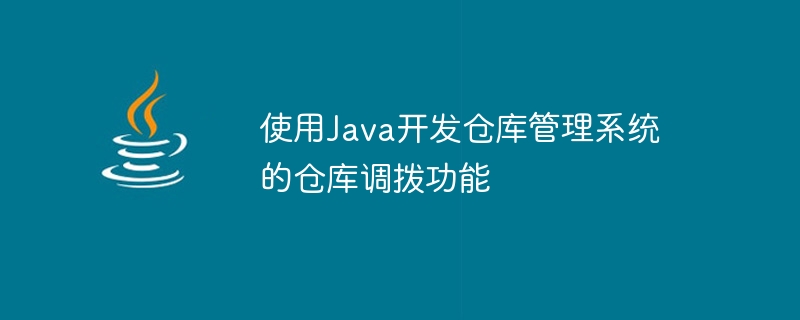Home >Java >javaTutorial >Using Java to develop the warehouse allocation function of the warehouse management system
Using Java to develop the warehouse allocation function of the warehouse management system
- WBOYWBOYWBOYWBOYWBOYWBOYWBOYWBOYWBOYWBOYWBOYWBOYWBOriginal
- 2023-09-26 09:54:111438browse

Title: Using Java to develop the warehouse allocation function of the warehouse management system
Introduction:
Warehouse allocation is one of the very important functions in the warehouse management system. It It can realize the mobilization and distribution of items in the warehouse and improve the operational efficiency of the warehouse. Based on the Java language, this article will introduce how to use Java to develop the warehouse allocation function of the warehouse management system, and provide specific code examples.
1. System requirements analysis
Before development, we need to conduct system requirements analysis to clarify the specific requirements for the warehouse allocation function. It mainly includes the following aspects:
- Process requirements for warehouse allocation: including application for allocation, allocation review, allocation execution and other steps.
- Management requirements for allocated items: including management of item classification, number, name, inventory and other information.
- Management requirements for transfer records: including management of transfer single numbers, transfer time, transfer quantity and other information.
- Permission requirements for the transfer process: including the permission control of different roles on the transfer process, such as transfer applicants, reviewers, executors, etc.
2. Database design
When designing the database, you can create three data tables: product table, allocation application form, and allocation record table. The specific table structure is as follows:
Goods table (goods):
Field name type description
id int product ID, primary key
name varchar product name
category varchar product classification
inventory int Product inventory
Transfer application form (transfer_request):
Field name type description
id int application ID, primary key
goods_id int product ID, foreign key associated product table
quantity int Transfer quantity
applicant_id int Applicant ID
apply_time datetime Application time
Transfer record table (transfer_record):
Field name type description
id int Record ID, primary key
goods_id int product ID, foreign key associated product table
quantity int allocation quantity
applicant_id int applicant ID
approver_id int reviewer ID
executor_id int executor ID
apply_time datetime application Time
approve_time datetime Review time
execute_time datetime Execution time
3. System implementation
- Create a Java project and import related dependent libraries, such as database drivers, etc.
- Define Java classes such as Goods, TransferRequest, and TransferRecord, which respectively correspond to the table structure in the database.
- Write the data access layer (DAO), including the addition, deletion, modification and query operations of the database, implemented using JDBC or a framework such as MyBatis.
- Write the business logic layer (Service) to correspond to the specific functional requirements of the system. This requirement mainly includes operations such as allocation application, review, and execution.
- Write the user interface layer (UI) and use interface libraries such as Swing or JavaFX to realize the visual interface of the warehouse allocation function.
- In the UI interface, specific operations of the allocation function are implemented by calling the Service layer method.
Specific code examples (taking JavaFX as an example):
Please note that the following example code is only a demonstration part of the code and may need to be modified appropriately according to actual needs:
-
Goods table entity class (Goods.java):
public class Goods { private int id; private String name; private String category; private int inventory; // getter and setter methods } -
Transfer application form entity class (TransferRequest.java):
public class TransferRequest { private int id; private int goodsId; private int quantity; private int applicantId; private LocalDateTime applyTime; // getter and setter methods } -
Transfer record table entity class (TransferRecord.java):
public class TransferRecord { private int id; private int goodsId; private int quantity; private int applicantId; private int approverId; private int executorId; private LocalDateTime applyTime; private LocalDateTime approveTime; private LocalDateTime executeTime; // getter and setter methods } -
Data access layer interface (DAO):
public interface GoodsDao { void add(Goods goods); void update(Goods goods); void delete(int id); Goods getById(int id); List<Goods> getAll(); } public interface TransferRequestDao { void add(TransferRequest request); void update(TransferRequest request); void delete(int id); TransferRequest getById(int id); List<TransferRequest> getAll(); } public interface TransferRecordDao { void add(TransferRecord record); void update(TransferRecord record); void delete(int id); TransferRecord getById(int id); List<TransferRecord> getAll(); } -
Business logic layer interface ( Service):
public interface TransferService { void applyTransfer(TransferRequest request); void approveTransfer(int requestId, int approverId); void executeTransfer(int recordId, int executorId); } - User interface layer (UI) (omitted)
Conclusion:
Through the above steps, we can develop the warehouse management system based on Java language Warehouse allocation function. Developers can improve the code according to specific needs and implement visual operations of the allocation function at the user interface layer. The realization of the warehouse allocation function will greatly improve the operational efficiency of the warehouse and achieve reasonable allocation of inventory. At the same time, we can also achieve a more complete warehouse management system by improving other functional modules.
The above is the detailed content of Using Java to develop the warehouse allocation function of the warehouse management system. For more information, please follow other related articles on the PHP Chinese website!
Related articles
See more- How to solve the error when docker pulls private warehouse image
- Database management systems typically provide authorization functionality to control what
- What is the so-called relationship in a relational database management system?
- What are the docker image warehouses?
- How to delete the warehouse on github

